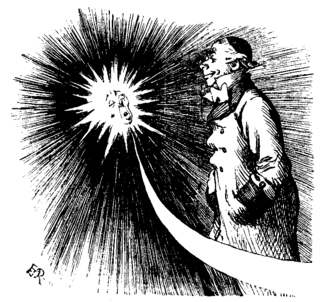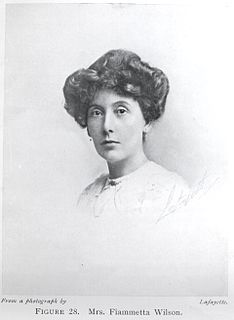Related Research Articles

Sir Frank Watson Dyson, KBE, FRS, FRSE was an English astronomer and the ninth Astronomer Royal who is remembered today largely for introducing time signals ("pips") from Greenwich, England, and for the role he played in proving Einstein's theory of general relativity.

Andrew Claude de la Cherois Crommelin was an astronomer of French and Huguenot descent who was born in Cushendun, County Antrim, Ireland. He was educated in England at Marlborough College and Trinity College, Cambridge. After a spell teaching at Lancing College he found permanent employment at the Royal Greenwich Observatory in 1891. He joined the Royal Astronomical Society in 1888 and was its president from 1929-1931. In 1895 he joined the British Astronomical Association and was president from 1904-1906 and directed its comet section 1898-1901 and 1907-1938.

William Frederick Denning was a British amateur astronomer who achieved considerable success without formal scientific training. He is known for his catalogues of meteor radiants, observations of Jupiter's red spot, and for the discovery of five comets. Outside astronomy, as a young man, Denning showed prowess at cricket to the extent W G Grace invited him to play for Gloucestershire. However Denning’s retiring nature made him decline the offer.
Philip Herbert Cowell FRS was a British astronomer.
Leslie John Comrie FRS was an astronomer and a pioneer in mechanical computation.
The British Astronomical Association (BAA) was formed in 1890 as a national body to support the UK's amateur astronomers.
The Reverend Thomas Henry Espinell Compton Espin or T. H. E. C. Espin was a British astronomer. His father Thomas Espin was Chancellor of the Diocese of Chester and his mother was Elizabeth.
William Herbert Steavenson FRAS was an English amateur astronomer.
Theodore Evelyn Reece Phillips, known as T. E. R. Phillips, was an English astronomer.
John Evershed CIE FRS FRAS was an English astronomer. He was the first to observe radial motions in sunspots, a phenomenon now known as the Evershed effect.
Hugh Percy Wilkins was a Welsh-born engineer and amateur astronomer.

The Liverpool Astronomical Society was founded in 1881 in Liverpool, England, as a society to promote and coordinate amateur astronomy.
The Astronomical Society of India (ASI) is an Indian society of professional astronomers and other professionals from related disciplines. It was founded in 1972, with Vainu Bappu being the founder President of the Society, and as of 2010 has a membership of approximately 1000. Its registered office is at the Astronomy Department, Osmania University, Hyderabad, India. Its primary objective is the promotion of Astronomy and related branches of science. It organises meetings, supports and tries to popularise Astronomy and related subjects and publishes the Bulletin of the Astronomical Society of India.
Mary Acworth Evershed was a British astronomer and scholar. Her work on Dante Alighieri was written under the pen name M.A. Orr. Although her middle name is increasingly appearing as Ackworth, this is incorrect. She always gave it as Acworth, and it appeared as such in both her obituaries. The one appearing in the Monthly Notices of the Royal Astronomical Society was written by her nephew A. David Thackeray, who presumably would have known. The first appearance of this incorrect version could well have occurred in the proposal of Mary to be a Fellow of the Royal Astronomical Society; the correct spelling appears when she was subsequently elected a Fellow.

Elizabeth Brown was a British astronomer and Quaker who specialized in solar observation, especially sunspots and solar eclipses.
Reginald Lawson Waterfield was a British hematologist known for his work in amateur astronomy, specialising in astrometry and the photography of comets. He was elected to the British Astronomical Association on 25 November 1914 and to the Royal Astronomical Society on 10 November 1916. Both elections being at the proposal of W H Steavenson. Waterfield served as Director of the British Astronomical Association Mars Section from 1931-1942 and its president from 1954–1956. For his work in astronomy he won the 1942 Jackson-Gwilt Medal. After World War II he had to use a wheelchair due to polio. The minor planet 1645 Waterfield is named jointly for him and his cousin William Francis Herschel Waterfield (1886-1933), who was also a member of the British Astronomical Association and Fellow of the Royal Astronomical Society.
Charles Thomas Whitmell was an English astronomer, mathematician and educationalist.

Fiammetta Wilson was a British astronomer elected a fellow of the Royal Astronomical Society in 1916.
George Frederick Chambers was an English barrister, amateur astronomer and author, who wrote a number of popular books about science.

Agnes Fry was a British bryologist, astronomer, botanical illustrator, writer and poet, who donated Failand House's Estate to the National Trust.
References
- ↑ Cannon, Annie J. (17 February 1921). "Report of the Astronomical Fellowship Committee". Annual Report of the Maria Mitchell Association. 19: 15–17. Bibcode:1921MMAAR..19...15C . Retrieved 11 January 2014.
- ↑ Larsen, Kristine (December 2006). "Shooting Stars: The Women Directors of the Meteor Section of the British Astronomical Association". The Antiquarian Astronomer . Society for the History of Astronomy. 3: 75–82. Bibcode:2006AntAs...3...75L.
- ↑ "Construction of new school starts as it takes name from pioneering female astronomer". Suffolk News. 14 September 2021. Retrieved 2 April 2022.
- ↑ "Grace Cook Primary School | Orwell Multi Academy Trust". www.omat.org.uk. Retrieved 2 April 2022.
- ↑ "OASI: A G Cook". www.oasi.org.uk. Retrieved 13 September 2021.
- ↑ "1911JBAA...21..247. Page 247". articles.adsabs.harvard.edu. Bibcode:1911JBAA...21..247. Retrieved 13 September 2021.
- ↑ "1914JBAA...25...76. Page 84". adsbit.harvard.edu. Retrieved 13 September 2021.
- ↑ "1916MNRAS..76..195. Page 195". articles.adsabs.harvard.edu. Bibcode:1916MNRAS..76..195. Retrieved 13 September 2021.
- ↑ "Franklin-Adams charts". Oxford Reference. Retrieved 12 October 2021.
- ↑ "1914MNRAS..74..699H Page 706". articles.adsabs.harvard.edu. Bibcode:1914MNRAS..74..699H . Retrieved 13 September 2021.
- ↑ "1916JBAA...27...34W Page 34". articles.adsabs.harvard.edu. Bibcode:1916JBAA...27...34W . Retrieved 13 September 2021.
- ↑ Lockyer, Norman (1869). Nature. Smithsonian Libraries. [London, etc., Macmillan Journals Ltd., etc.]
- ↑ "1920Obs....43..367. Page 372". articles.adsabs.harvard.edu. Bibcode:1920Obs....43..367. Retrieved 13 September 2021.
- ↑ "1924MmBAA..24...49. Page 49". articles.adsabs.harvard.edu. Bibcode:1924MmBAA..24...49. Retrieved 13 September 2021.
- ↑ "1922MNRAS..82..430T Page 430B". articles.adsabs.harvard.edu. Retrieved 16 September 2021.